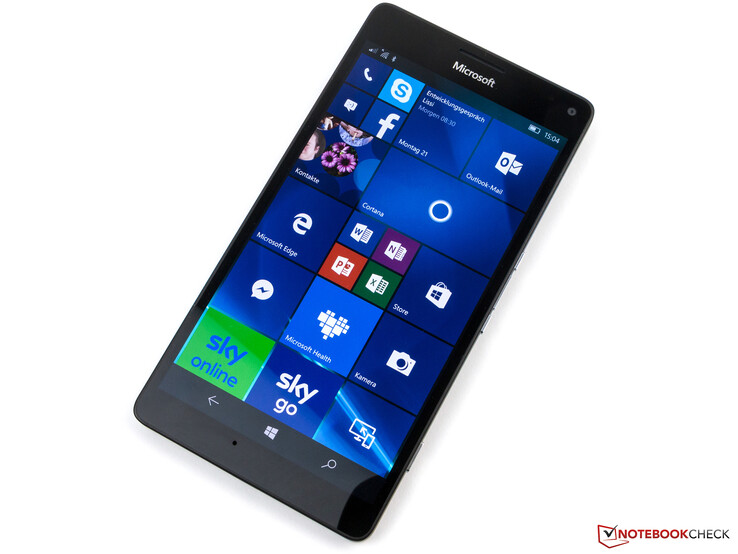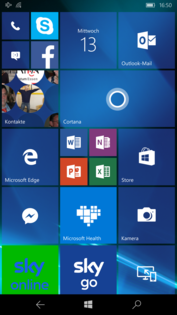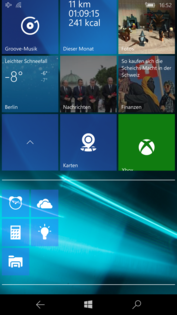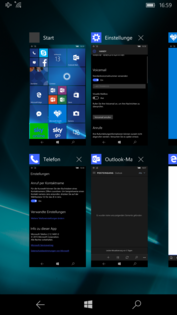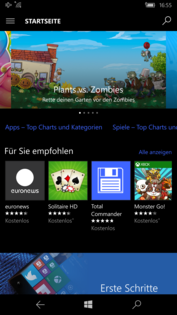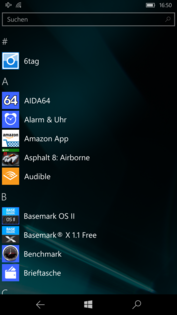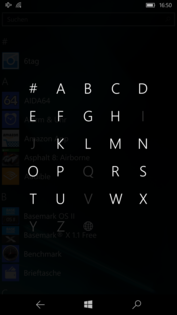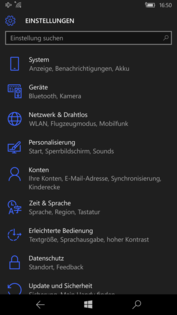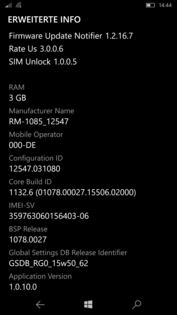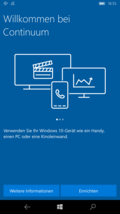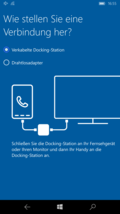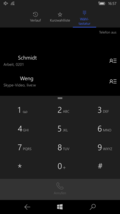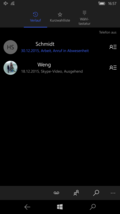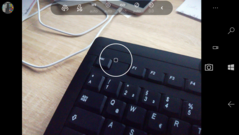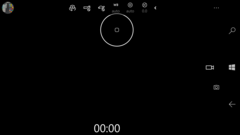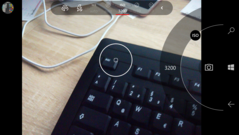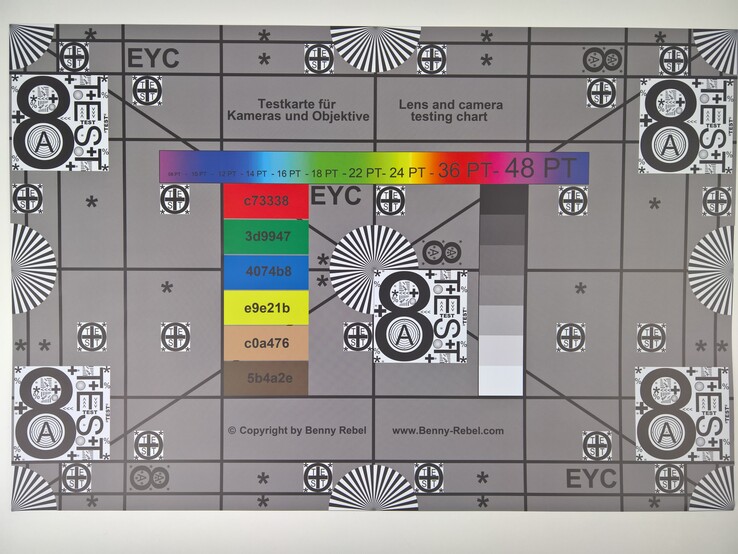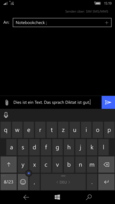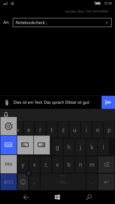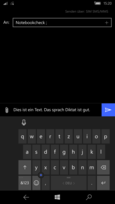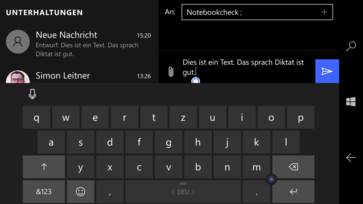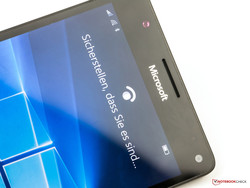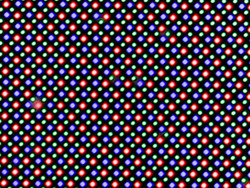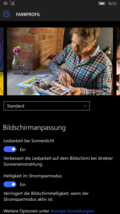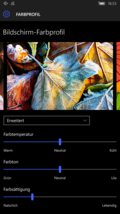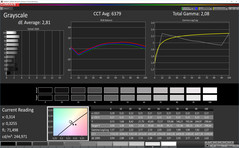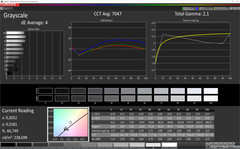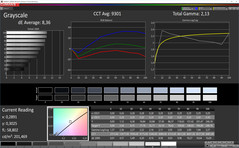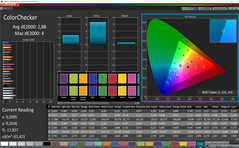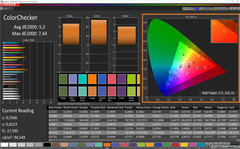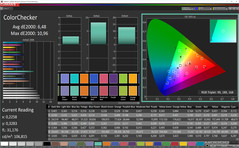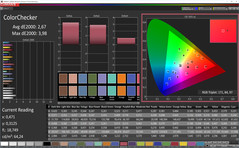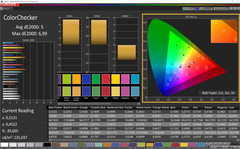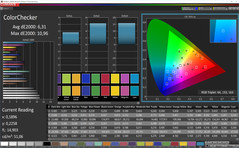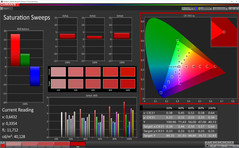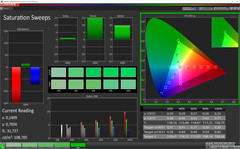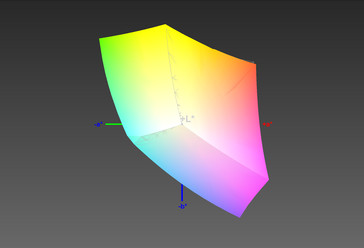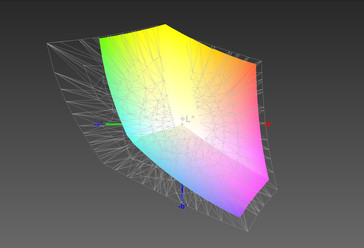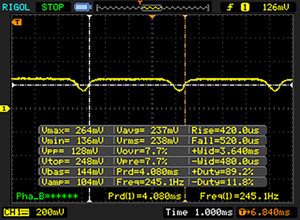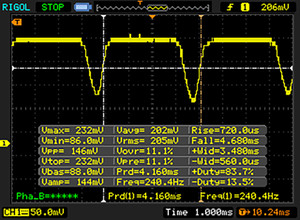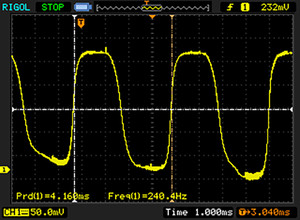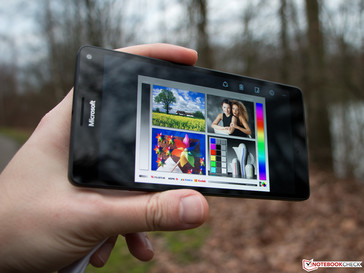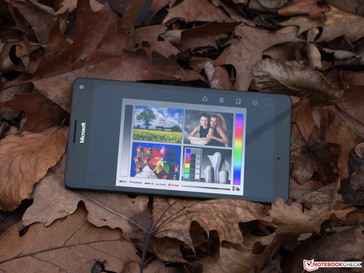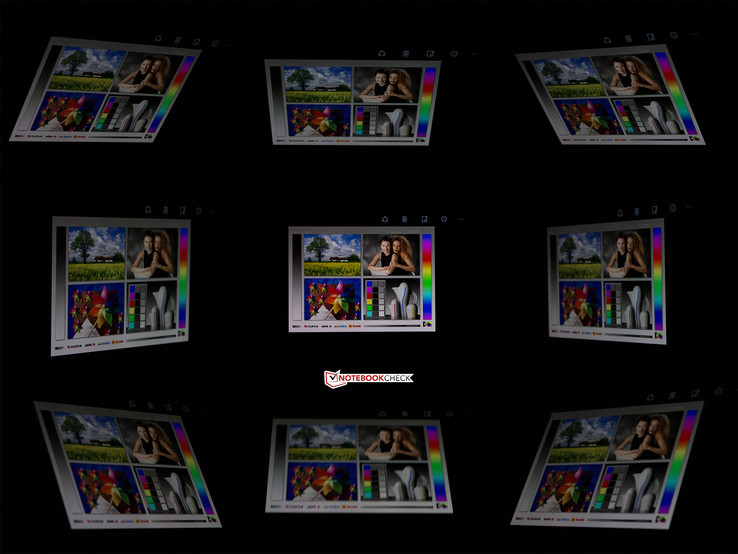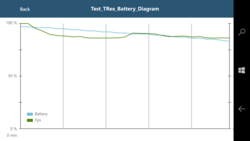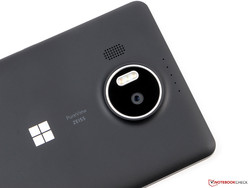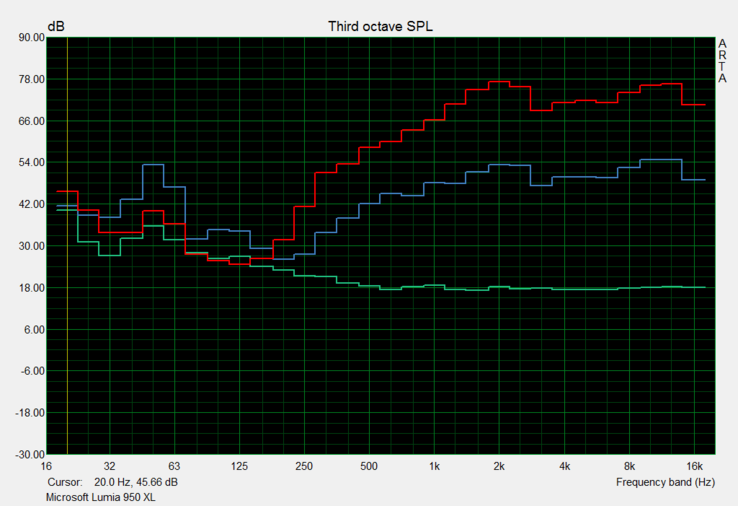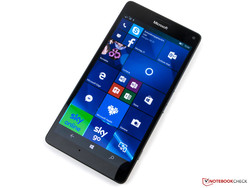Microsoft Lumia 950 XL Smartphone Review
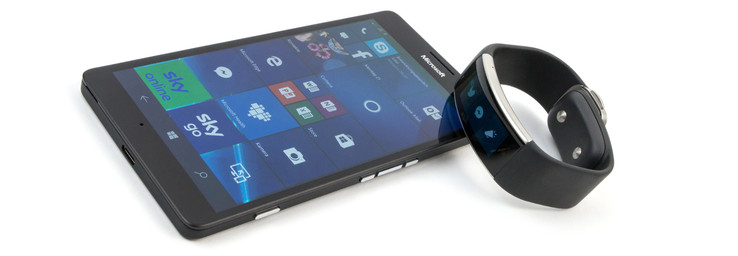
For the original German review, see here.
The Microsoft Lumia 950 XL is the bigger model of the two high-end models from Redmond and is equipped with the latest technology. Sufficient performance is provided by the Snapdragon 810. 3 GB RAM and 32 GB flash storage are a solid foundation, especially since the latter can be expanded via microSD-card. The XL version sports a 5.7-inch QHD display with a razor-sharp picture. A modern USB Type-C port is also implemented, so there is hardly anything missing. Microsoft charges 699 Euros (~$760) for the top model; the smaller Lumia 950 (Snapdragon 808, 5.2-inch display) is around 100 Euros (~$108) less expensive.
The competition is massive when you leave the Windows universe. Suitable rivals in this size are, among others, the Samsung Galaxy S6 Edge+, Motorola Moto X Style and the Google Nexus 6P. A bit more compact are the LG G4, Sony Xperia Z5, OnePlus 2, Apple iPhone 6s Plus as well as the HTC One M9, but they are still strong competitors.
Case
We already expected the dimensions of the Lumia 950 XL due to the 5.7-inch panel, but the device is still surprisingly compact. It is around 0.5 mm wider and 1 mm thicker than the smaller iPhone 6s Plus but also around 6 millimeters shorter. We measured a thickness of 8.5 millimeters, and the Lumia 950 XL even measures around 10 millimeters at the camera bump. This sounds like a lot, but the Moto X Style (up to 11.1 mm) is even a bit thicker.
Twisting attempts and heavy pressure are no problem for the review unit. There is some minor creaking, but this is probably caused by the removable back cover, which is made of polycarbonate. It is easy to remove thanks to a small indentation and grants access to the removable battery as well as the nano-SIM and microSD-slot. Both slots have spring-loaded ejection mechanisms, which increases the comfort and supports the level of sophistication.
This cannot really be said about the design of the Lumia 950 XL. It is very simple and the polycarbonate does not leave a noble impression, either. You do not get the impression you are using a premium device, even though the build quality is on a very good level. If you prefer a better design, you should have a look at the back covers from Mozo, which is an official partner of Microsoft. They also offer versions with leather and metal, but this will increase the price by at least 55 Euros (~$59). The review unit is available in black and white.
Connectivity
Microsoft does not make any compromises in terms of the connectivity. The internal storage can by expanded via microSD-card slot, which currently supports memory cards with a capacity of up to 200 GB. It is also possible to attach external drives via USB port, which supports OTG and can therefore also recognize external input devices. The connector is based on the new Type-C standard. You do not just get an old USB 2.0 port though; you get a USB 3.1 (Gen 1) port that supports transfer rates of up to 5 Gbps. The port also supports MHL 3.1 and can be used as a DisplayPort in combination with an optional adapter.
The Lumia 950 XL offers quite a lot in respect of wireless technologies. Besides NFC, you also get Bluetooth 4.1. The latter does not represent the latest version, but this won't be a big deal for the majority of users. The smartphone supports Wi-Fi Direct and Miracast for the wireless transmission of video signals. Inductive charging is once again possible, and you can make use of Quick Charge with the provided power adapter.
The only thing we missed was an infrared transmitter to control external devices. You do not get a fingerprint scanner, either, but this is more than compensated for by the iris scanner and Windows Hello.
Software
The Microsoft Lumia 950 XL is one of the first smartphones that is shipped with the new Windows 10 Mobile. The familiar UI with tiles from Windows Phone 8.x is still available. The tiles can be shown in three sizes. Users of older models should not have any problems, because the handling principles did not change.
There is a visual facelift, which now supports background pictures. The tiles can be made transparent (seamless) and still show the familiar live information. The bar with quick settings can now be folded out and grants an even quicker access to the most important features of the device.
If the device shows a pop-up notification, you can pull it to the bottom to answer it directly. This, among others, is a great feature and Windows 10 Mobile leaves a good impression as an operating system in general. Office got an update and all the functions are still available on the Lumia, even if the user does not own Office 365. The new Microsoft browser Edge is included as well.
The design language of the operating system from Redmond is very consistent, and the announced universal apps, which are supposed to be available on the PC, tablet and smartphone, are certainly appealing. The realization is currently a problem though, because such apps are still rare. You will be confronted with the old problem of mobile Windows versions in practice: The app selection is often a limiting factor. Instagram, for example, is still a beta version according to the designation in the store and you can also only get the official app for Twitter. Snapchat is not available for Windows 10 at all, and there is no official app for Pinterest, either. Amazon Prime customers also have to waive the Instant Video app. This list can be continued; Microsoft has to improve the situation pretty quickly and make Windows 10 Mobile more attractive. A good counter example is the Xing app for Windows, which is excellent. Skype is pretty well-integrated into the operating system, too.
Continuum
Continuum is a powerful tool of Windows 10 Mobile. It enables the user to use the smartphone as a PC replacement. The Lumia 950 XL can either be attached wirelessly or via cable (Microsoft Display Dock) to an external monitor. The presentation of Windows 10 is now even more similar to a PC and there is even a desktop instead of the tiles interface. Unfortunately, there was no Display Dock available at the time of writing, but we could get a first in-depth impression during a presentation.
The optional Display Dock has a USB Type-C port at the front to attach the smartphone, which is directly charged. Another Type-C port powers the dock. Furthermore, you get three USB 2.0 ports to attach peripherals as well as one HDMI and DisplayPort. The use of a mouse and keyboard is therefore quick and easy and it is possible to use the Lumia smartphone as a touchpad. It is also possible to use Continuum wirelessly via Miracast, but the picture quality was better via Display Dock. However, the quality will also be linked to the corresponding receiver, and the Amazon FireTV Stick that we used is probably not the perfect choice. The picture was not transmitted in Full HD, but in a lower resolution with a 4:3 screen ratio. A mouse can easily be attached to the USB port of the smartphone.
If Miracast is not stable enough and the dock is too expensive, you can also use a simple USB Type-C to HDMI cable to use Continuum. Those cables start at around 9 Euros (~$9.70) depending on the quality.
Continuum is basically predestined for word processing and the like. But you will be surprised when you use the smartphone in this mode for the first time, because the Office use in Continuum requires an Office 365 license. Otherwise, the situation is similar to Android and iOS, where you can only read documents, but not edit them. There was a lot of criticism, so Microsoft now throws in a one-year license for free when you buy the Lumia 950 XL. This license is available via the Lumia Offers app.
In combination with a remote desktop connection, the Continuum operation of the smartphone could be particularly interesting for companies with WTS environments. But it seems that Microsoft blocks the user, because none of these apps could be launched from the desktop. We contacted Microsoft to find out whether this is intentional or if this feature will be provided later. We will update the review as soon as we have new information.
Continuum is still a great idea that is well implemented. There will certainly be some users that are completely satisfied with the experience and replace the slow PC at home.
Update: We've added a demonstration video below that shows Continuum and Miracast being used in unison to provide an extended, projected screen experience.
Communication & GPS
The Microsoft Lumia 950 XL can use mobile Internet via HSPA+ or fast LTE Cat. 6 (up to 300 Mbps). We did not experience any connection issues or other abnormalities during the test period. The coverage of frequencies is also very high, so there should not be any problems within Europe. You should also still be covered outside of Europe.
The integrated Wi-Fi module from Qualcomm supports the IEEE 802.11 standards a/b/g/n and ac. It supports both 2.4 as well as 5.0 GHz networks as well as the MIMO antenna technology. The range of the Wi-Fi connection is very good: We still had a good signal even with a distance of around 20 meters to the access point (Devolo dLAN 1200+ Wi-Fi ac) and with three interior walls in between. Even HD video streams in the Netflix app were transmitted without issues.
Microsoft's Lumia 950 XL uses the GPS and GLONASS satellite networks to locate its position. This process was subjectively very quick and pretty precise indoors. Corresponding apps to check the accuracy even more precisely are not available in the Microsoft Store. There is also a barometer to determine the height.
We took the Lumia 950 XL on a small bike ride to check the results and compared them with the Garmin Edge 500. The smartphone performs very well. It is not quite as accurate as the bicycle navigation device, but it can usually stay on the right path and locates the position quite often, so it is pretty accurate. The overall deviation on the 11 km track was just 70 meters.
Telephone & Voice Quality
The phone app of the Microsoft Lumia 950 XL is very simple. You won't have any problems if you have ever used a smartphone before. There are three main screens: a simple history, a speed-dial list as well as the typical numbers pad with a reduced history. Users will be happy that the communication software is pretty well-integrated, because incoming, missed and outgoing Skype calls are also listed here.
Unfortunately, the voice quality of the Lumia 950 XL cannot fully convince us. Both the voices of the caller and the recipient are very clear and there is no static, but there are still small dropouts from time to time. This is the case when we hold the Lumia to our ear and also when we used the hands-free feature. The latter is pretty sensitive and still works pretty well when the smartphone is lying on the table next to you, but there are audible echoes.
Cameras
At the front of the Lumia 950 XL is a 5 MP camera (2592x1936 pixels), which takes pretty decent pictures and works well for selfies. It only has a fixed focus, but this is common for almost all manufacturers. Microsoft does not include a support light and we were surprised how much light the sensor can capture in dark environments, even though visible picture noise cannot be avoided in this case.
The main camera at the back can take pictures with up to 20 MP (4864x3648 pixels, 4:3), but only 17.7 MP is effectively used for jpg-pictures, the rest is reserved for the digital zoom. Pictures in the DNG format can use up to 19 MP and you can edit them later on the PC without losses.
We liked the quality of the pictures during our review. The results are good under daylight and benefit from the good white balance in particular. The sharpness is also okay but cannot keep up with the iPhone 6s Plus or the Xperia Z5 Premium. The big strength of the Lumia 950 XL is the performance in low-light situations or with back light, where it can surpass the competition. The pictures are clearer and also appear brighter. The three-colored LED flash is supposed to ensure pretty natural colors in the dark.
The features also changed a bit with the new camera app. You still get the features from the Lumia 930 and the 1520, so it is still possible to save individual pictures from a video or use the comprehensive manual mode. A new function for video recordings is the slow-motion mode, but it is only available in the smaller HD resolution (up to 720p, 120 fps).
Videos can be recorded in numerous resolutions with the Lumia 950 XL. It supports 720p (24, 25, 30 or 60 fps), 1080p (24, 25, 30 or 60 fps) and 2160p (24, 25 or 30 fps). Thanks to the optical image stabilizer, the free-hand results are also pretty good, and the video quality is on a good level. Movements are not a big issue for the smartphone and the sharpness can convince as well. The bit rates are also pretty high; an FHD video (60 fps) has a bit rate of around 35 Mbps and even 53 Mbps at the full resolution (UHD, 2160p, 30 fps). For comparison: The iPhone 6s Plus takes videos at 26 and 50 Mbps, respectively. The microphone quality is also decent, but it is pretty susceptible to wind noises.
Color Accuracy & Sharpness
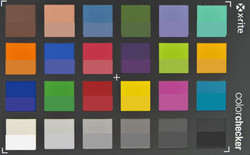
To check the color accuracy of the Microsoft Lumia 950 XL, we took a picture of the ColorChecker passport under controlled lighting conditions. We only use the automatic mode of the smartphone, and the results are not edited afterwards. The colors are a bit saturated, but this does not look too bad, while earthy tones appear pretty natural.
We use another chart to evaluate the sharpness, which is also photographed under artificial light. The Lumia 950 XL is once again pretty good and the picture is razor-sharp in the center; the edges are only a bit blurry towards the sides. There are smaller problems with the fonts and the color gradients, where we can see slight imaging errors.
Accessories
The box of the Microsoft Lumia 950XL only includes a power adapter with a nominal output of 15 Watts (5 V, 3 A), which has a fixed cable, as well as a separate data cable (USB Type-A to Type-C).
There are optional accessories like cases, headphones, charging cushions and battery packs, which are available in Microsoft's shop. You can also get the new Display Dock (109 Euros, ~$118), which can be ordered as a free extra at the time of the review, as well as a Miracast receiver.
Warranty
Microsoft grants a 24-month warranty for its product. The battery, the data cable and the power adapter are only covered for six months. It is not possible to extend the warranty period.
Input Devices & Handling
The Microsoft Lumia 950 XL has a 5.7-inch capacitive touchscreen, which is protected by Corning Gorilla Glass 4. The gliding capabilities are very good and inputs are precisely executed even in the peripheral areas. The touchscreen is particularly convincing when you type on the on-screen keyboard.
The keyboard layout slightly changed in Windows 10 Mobile. Thanks to a TrackPoint, you can now easily put the cursor on the desired position in texts. It is also possible to reduce the size of the keyboard, so it is easier to use with just one hand. If possible, the whole input can be shifted across the screen. The quality of the input is not reduced compared to previous versions, but it still gives away some space in landscape mode.
The physical buttons have a comfortable pressure point and are very reliable. The Lumia 950 XL also has a dedicated camera button with two pressure levels. The first one is to focus the picture and the second to trigger the camera. It is possible to launch the camera with the button from standby. However, it still requires an identification if you use Windows Hello. The two volume buttons surround the power button. This is a bit unusual at first, but you get used to it very quickly thanks to the clear tactile difference.
Windows Hello
The user authentication Windows Hello, which we already know from the Surface Pro 4, is also available on the Lumia 950 XL. There is, however, one important difference: While the Surface uses a RealSense camera to check the identity of the user, the smartphone uses an infrared iris scan. The big advantage is that authentication is also possible in the dark or if you wear glasses, for example.
The setup of Windows Hello is a very easy and quick process. The recognition works very accurately and is reliable at a distance of around 40 centimeters, and the Lumia will ask you to reduce the distance when you are further away. It is also still possible to unlock the device via PIN code.
For now, Windows Hello can only be used to unlock the smartphone. A deeper app integration, which can authenticate purchases, is currently not available.
The unlocking mechanism itself is a bit long due to the animation. You can only notice how fast the technology actually is when you want to launch the camera app from standby. If you cover the sensor, it cannot be launched; otherwise it opens without a delay.
Display
With its 5.7-inch display, the Lumia 950 XL can actually be called a phablet. Microsoft once again uses an AMOLED screen, but the resolution was bumped to 2560x1440 pixels this time, so the pixel density at 515 PPI is even higher compared to the smaller predecessor Lumia 930 (5.0-inch, 1080p, 441 PPI). The iPhone 6s Plus only reaches 401 PPI. A higher pixel density is currently only managed by the Xperia Z5 Premium, which is the only Ultra-HD smartphone at the time of this review. You can clearly argue about the sense of such a high resolution, but the Lumia 950 XL is definitely razor-sharp and you cannot see individual pixels with the naked eye.
Our display measurements are performed at the highest luminance, without the ambient light sensor and with a pure white background. The brightness distribution is very good at 93%, but the average luminance is not really overwhelming at 297 cd/m². However, this impression is misleading. An even distribution of white and black content (APL 50) results in an increase by 30 cd/m², and we can measure up to 683 cd/m² with the activated light sensor, which is a great result.
Because of the AMOLED technology, black content is actually not illuminated and is completely black all the time. This results in a contrast ratio that tends towards infinity and therefore does not cause any criticism.
| |||||||||||||||||||||||||
Brightness Distribution: 93 %
Center on Battery: 297 cd/m²
Contrast: ∞:1 (Black: 0 cd/m²)
ΔE ColorChecker Calman: 2.67 | ∀{0.5-29.43 Ø4.78}
ΔE Greyscale Calman: 2.81 | ∀{0.09-98 Ø5}
99.79% sRGB (Argyll 1.6.3 3D)
66.31% AdobeRGB 1998 (Argyll 1.6.3 3D)
72.5% AdobeRGB 1998 (Argyll 3D)
99.8% sRGB (Argyll 3D)
70.9% Display P3 (Argyll 3D)
Gamma: 2.08
CCT: 6379 K
| Microsoft Lumia 950 XL Adreno 430, 810 MSM8994, 32 GB eMMC Flash | Samsung Galaxy S6 Edge Mali-T760 MP8, Exynos 7420, 32 GB UFS 2.0 Flash | LG G4 Adreno 418, 808 MSM8992, 32 GB eMMC Flash | Apple iPhone 6S Plus A9 / PowerVR GT7600, A9, Apple AP0064K (iPhone NVMe) | Motorola Moto X Style Adreno 418, 808 MSM8992, 32 GB eMMC Flash | Google Nexus 6P Adreno 430, 810 MSM8994, 32 GB eMMC Flash | Huawei Mate S Mali-T628 MP4, Kirin 935, 32 GB eMMC Flash | |
|---|---|---|---|---|---|---|---|
| Screen | 16% | -13% | 13% | 29% | 23% | -37% | |
| Brightness middle (cd/m²) | 297 | 343 15% | 566 91% | 583 96% | 538 81% | 363 22% | 352 19% |
| Brightness (cd/m²) | 297 | 338 14% | 536 80% | 560 89% | 528 78% | 365 23% | 350 18% |
| Brightness Distribution (%) | 93 | 94 1% | 90 -3% | 91 -2% | 92 -1% | 90 -3% | 87 -6% |
| Black Level * (cd/m²) | 0.47 | 0.46 | 0.66 | ||||
| Colorchecker dE 2000 * | 2.67 | 2.2 18% | 6.17 -131% | 3.55 -33% | 2.63 1% | 2.34 12% | 4.95 -85% |
| Colorchecker dE 2000 max. * | 3.98 | ||||||
| Greyscale dE 2000 * | 2.81 | 2.37 16% | 6.26 -123% | 3.88 -38% | 3.24 -15% | 1.03 63% | 6.54 -133% |
| Gamma | 2.08 106% | 2.41 91% | 2.48 89% | 2.2 100% | 2.17 101% | 2.23 99% | 2.27 97% |
| CCT | 6379 102% | 6425 101% | 8171 80% | 7280 89% | 6906 94% | 6429 101% | 6943 94% |
| Color Space (Percent of AdobeRGB 1998) (%) | 66.31 | 87.77 32% | 65.48 -1% | 59.05 -11% | |||
| Color Space (Percent of sRGB) (%) | 99.79 | 98.63 -1% | 92.8 -7% | ||||
| Contrast (:1) | 1204 | 1267 | 815 |
* ... smaller is better
The picture quality of the Microsoft Lumia 950 XL is pretty convincing as well: The sRGB color space is almost covered completely, and the wider Adobe RGB color space is still covered by around two-thirds. Users can choose between three predefined color profiles, and there is even an advanced mode where you can adjust the settings to your own preferences.
A comparatively natural presentation is provided by the profile "Standard," which is selected by default. We also measured the screen in this mode. The grayscale presentation is very good with a maximum DeltaE deviation of 3.3. The ColorChecker reveals a similar picture: We can see one shade of gray with a DeltaE of 4, and red is pretty close to this value as well, but you can hardly see this deviation with the naked eye. The saturation is slightly increased but is still conveniently low for an OLED screen. The profile "Vivid" will increase the saturation and the mode "Cool" results in a blue cast.
Display Response Times
| ↔ Response Time Black to White | ||
|---|---|---|
| 0.9 ms ... rise ↗ and fall ↘ combined | ↗ 0.42 ms rise | |
| ↘ 0.52 ms fall | ||
| The screen shows very fast response rates in our tests and should be very well suited for fast-paced gaming. In comparison, all tested devices range from 0.1 (minimum) to 240 (maximum) ms. » 2 % of all devices are better. This means that the measured response time is better than the average of all tested devices (20.2 ms). | ||
| ↔ Response Time 50% Grey to 80% Grey | ||
| 5.4 ms ... rise ↗ and fall ↘ combined | ↗ 0.72 ms rise | |
| ↘ 4.68 ms fall | ||
| The screen shows very fast response rates in our tests and should be very well suited for fast-paced gaming. In comparison, all tested devices range from 0.165 (minimum) to 636 (maximum) ms. » 16 % of all devices are better. This means that the measured response time is better than the average of all tested devices (31.7 ms). | ||
Screen Flickering / PWM (Pulse-Width Modulation)
| Screen flickering / PWM detected | 240 Hz | ||
The display backlight flickers at 240 Hz (worst case, e.g., utilizing PWM) . The frequency of 240 Hz is relatively low, so sensitive users will likely notice flickering and experience eyestrain at the stated brightness setting and below. In comparison: 53 % of all tested devices do not use PWM to dim the display. If PWM was detected, an average of 8142 (minimum: 5 - maximum: 343500) Hz was measured. | |||
The AMOLED screen ensures good viewing-angle stability and there are no color inversions. You can, however, notice a slight green cast when the viewing angle exceeds 45 degrees, but this is no problem in practice. Reflections due to light sources in the dark or under direct sunlight can affect the visibility from the side.
Performance
Similar to many 2015 high-end smartphones, the Lumia 950 XL is equipped with a Qualcomm Snapdragon 810 MSM8994 and is supported by 3 GB RAM. The graphics unit of the SoC is the Adreno 430 and is still one of the fastest chips in the mobile sector. The processor itself is based on the big.LITTLE concept and consists of two clusters with four cores each. The first cluster consists of powerful Cortex-A57 cores that run at up to 2.0 GHz. The second cluster uses four Cortex-A53 cores clocked at up to 1.5 GHz.
The number of cross-platform benchmarks in the Windows Store is unfortunately still limited. GFXBench evaluates the graphics performance of the smartphone. Contrary to the Android competitors, however, Windows does not use the OpenGL interface, but DirectX. This means the results are sometimes much lower compared to nominally similarly fast systems. The situation changes in Basemark X 1.1, where the Lumia 950 XL can even just beat the Galaxy S6 Edge+ (Exynos 7420, Mali T760) and is also 18% faster than the HTC One M9 with the identical SoC.
The Linpack test for Windows 10 Mobile can finally utilize all cores of the Snapdragon 810 and gets a score that surpasses all other devices. Even the iPhone 6s Plus cannot compete against the full octa-core performance and is only half as fast when it uses all cores.
It is tricky to determine the storage performance of a Windows device. The available apps either give us contradictory results or don't work. Only Basemark OS II is a rough indicator and shows a very high storage performance for the Lumia 950 XL.
Microsoft managed to close a big part of the gap to the Chrome competition with the Edge browser. Only a few competitors like the Nexus 6P or the iPhone 6s Plus are faster in all benchmarks. The subjective performance of Microsoft's new browser is also very good.
| GFXBench (DX / GLBenchmark) 2.7 | |
| T-Rex Onscreen (sort by value) | |
| Microsoft Lumia 950 XL | |
| Nokia Lumia 930 | |
| Google Nexus 6P | |
| Motorola Moto X Style | |
| HTC One M9 | |
| Sony Xperia Z5 | |
| Huawei Mate S | |
| Apple iPhone 6S Plus | |
| 1920x1080 T-Rex Offscreen (sort by value) | |
| Microsoft Lumia 950 XL | |
| Nokia Lumia 930 | |
| Google Nexus 6P | |
| Motorola Moto X Style | |
| HTC One M9 | |
| Sony Xperia Z5 | |
| Huawei Mate S | |
| Apple iPhone 6S Plus | |
| GFXBench 3.0 | |
| on screen Manhattan Onscreen OGL (sort by value) | |
| Microsoft Lumia 950 XL | |
| Google Nexus 6P | |
| Samsung Galaxy S6 Edge+ | |
| Motorola Moto X Style | |
| HTC One M9 | |
| Sony Xperia Z5 | |
| Huawei Mate S | |
| Apple iPhone 6S Plus | |
| 1920x1080 1080p Manhattan Offscreen (sort by value) | |
| Microsoft Lumia 950 XL | |
| Google Nexus 6P | |
| Samsung Galaxy S6 Edge+ | |
| Motorola Moto X Style | |
| HTC One M9 | |
| Sony Xperia Z5 | |
| Huawei Mate S | |
| Apple iPhone 6S Plus | |
| Basemark X 1.1 - Medium Quality (sort by value) | |
| Microsoft Lumia 950 XL | |
| Nokia Lumia 930 | |
| Samsung Galaxy S6 Edge+ | |
| HTC One M9 | |
| JetStream 1.1 - Total Score (sort by value) | |
| Microsoft Lumia 950 XL | |
| Google Nexus 6P | |
| Samsung Galaxy S6 Edge+ | |
| Motorola Moto X Style | |
| HTC One M9 | |
| Sony Xperia Z5 | |
| Huawei Mate S | |
| Apple iPhone 6S Plus | |
| Octane V2 - Total Score (sort by value) | |
| Microsoft Lumia 950 XL | |
| Nokia Lumia 930 | |
| Google Nexus 6P | |
| Samsung Galaxy S6 Edge+ | |
| Motorola Moto X Style | |
| HTC One M9 | |
| Sony Xperia Z5 | |
| Huawei Mate S | |
| Apple iPhone 6S Plus | |
| Mozilla Kraken 1.1 - Total (sort by value) | |
| Microsoft Lumia 950 XL | |
| Nokia Lumia 930 | |
| Google Nexus 6P | |
| Samsung Galaxy S6 Edge+ | |
| Motorola Moto X Style | |
| HTC One M9 | |
| Sony Xperia Z5 | |
| Huawei Mate S | |
| Apple iPhone 6S Plus | |
| WebXPRT 2015 - Overall (sort by value) | |
| Microsoft Lumia 950 XL | |
| Google Nexus 6P | |
| Samsung Galaxy S6 Edge+ | |
| Motorola Moto X Style | |
| HTC One M9 | |
| Sony Xperia Z5 | |
| Huawei Mate S | |
| Apple iPhone 6S Plus | |
* ... smaller is better
Games
Thanks to its very fast SoC, the Lumia 950 XL is well-equipped for all games from the Microsoft Store and is currently not brought to its limits. The large and high-resolution display also looks good with simple titles, offers great gliding capabilities and it is very responsive. The sensors also work well and do not affect the gaming experience. The position of the speaker at the back on the other hand is not perfect; you can soon cover it with a finger when you use the phablet in landscape mode.
Emissions
Temperature
The whole chassis of the Microsoft Lumia 950 XL warms up to more than 30 °C even while idling. Under load, which is simulated by the game Asphalt 8, the device can get quite warm and we can measure more than 48 °C at one spot at the front. This is comparatively hot, rivals like the Galaxy S6 Edge+ or the Nexus 6P stay below 40 °C and the iPhone 6s Plus is five degrees cooler as well, but the result is still not critical.
Microsoft talked about a liquid cooling during the presentation. Several teardowns actually showed that the smartphone is equipped with a real heat pipe. We checked if there is a positive effect on the performance under sustained load with the GFXBench Battery test, which repeats the T-Rex test 30 times and logs the frame rate as well as the battery charge. It turns out that Microsoft is the only manufacturer that can handle the Snapdragon 810. The Lumia 950 XL also loses some performance, but the drop is comparatively small at 14.5%. Other smartphones with the same SoC suffer from bigger performance drops, it does not matter if you look at the LG Flex 2 (-16.2%), OnePlus 2 (-33%), Sony Xperia Z5 (-29%), Nexus 6P (-31%) or HTC One M9 (-38%).
(-) The maximum temperature on the upper side is 48.3 °C / 119 F, compared to the average of 35.2 °C / 95 F, ranging from 21.9 to 247 °C for the class Smartphone.
(-) The bottom heats up to a maximum of 45.8 °C / 114 F, compared to the average of 34 °C / 93 F
(±) In idle usage, the average temperature for the upper side is 32.8 °C / 91 F, compared to the device average of 32.9 °C / 91 F.
Speakers
The speaker of the Microsoft Lumia 950 XL is awkwardly positioned and is close to the camera at the back of the smartphone. Because of that, and the protruding camera lens that raises the smartphone a bit, you can also put it on a table and the sound will not be muffled too badly. At almost 85 dB(A), the mono speaker is also quite loud.
The sound quality is decent. Our Pink Noise measurement is pretty steady starting with the upper-medium tones up to the super-high tones, there is only a small drop for the medium high tones. Among others, this range covers sibilants of the human voice. This results in a slightly tinny sound in practice, which is particularly noticeable at higher volumes. Bass on the other hand is hardly present at all.
Subjectively, the stereo jack delivers a clean sound without any noise and the performance is inconspicuous.
Energy Management
Power Consumption
The power consumption of the Lumia 950 XL is comparatively high while idling. The phablet has a bigger screen and a higher resolution, but this is also the case for the Nexus 6P with very similar specs, which consumes significantly less power. The comparison devices are pretty close under load.
The results when the device is turned off as well as during standby are exemplary. The latter is increased to 0.26 Watts with the activated iris scan. The power adapter consumes around 0.02 Watts at the socket.
Both Quick Charge as well as wireless charging (Qi standard) are supported. The provided power adapter can charge the battery of the Lumia to 50% within 30 minutes, and it is fully charged after another hour. The wireless charging time will be a bit higher since the current is lower.
| Off / Standby | |
| Idle | |
| Load |
|
Key:
min: | |
| Microsoft Lumia 950 XL Adreno 430, 810 MSM8994, 32 GB eMMC Flash | Apple iPhone 6S Plus A9 / PowerVR GT7600, A9, Apple AP0064K (iPhone NVMe) | Google Nexus 6P Adreno 430, 810 MSM8994, 32 GB eMMC Flash | Motorola Moto X Style Adreno 418, 808 MSM8992, 32 GB eMMC Flash | Sony Xperia Z5 Adreno 430, 810 MSM8994, 32 GB eMMC Flash | Huawei Mate S Mali-T628 MP4, Kirin 935, 32 GB eMMC Flash | |
|---|---|---|---|---|---|---|
| Power Consumption | 49% | 43% | 43% | 41% | 53% | |
| Idle Minimum * (Watt) | 2.85 | 0.5 82% | 0.83 71% | 0.7 75% | 0.7 75% | 0.6 79% |
| Idle Average * (Watt) | 2.95 | 1.9 36% | 1.09 63% | 2.2 25% | 1.7 42% | 1.2 59% |
| Idle Maximum * (Watt) | 3.26 | 2.2 33% | 1.17 64% | 2.3 29% | 1.8 45% | 1.6 51% |
| Load Average * (Watt) | 8.92 | 3.2 64% | 7.49 16% | 3.9 56% | 5.6 37% | 4.1 54% |
| Load Maximum * (Watt) | 9.39 | 6.4 32% | 9.51 -1% | 6.8 28% | 8.7 7% | 7.4 21% |
* ... smaller is better
Battery Runtime
The high consumption values of the Microsoft Lumia 950 XL drain the 3340 mAh battery pretty quickly and result in rather mediocre runtimes within the comparison. Some of the rivals last much longer, but the stamina of the review unit is still very good, even though Microsoft can certainly improve the results a bit with a software update.
Especially our pretty realistic Wi-Fi surfing test at an adjusted display brightness (150 cd/m²) does not determine a good result for our review unit. The performance is much better in the video test and is only beaten by the iPhone 6s Plus.
| Microsoft Lumia 950 XL Adreno 430, 810 MSM8994, 32 GB eMMC Flash | Samsung Galaxy S6 Edge+ Mali-T760 MP8, Exynos 7420, 32 GB UFS 2.0 Flash | Motorola Moto X Style Adreno 418, 808 MSM8992, 32 GB eMMC Flash | Google Nexus 6P Adreno 430, 810 MSM8994, 32 GB eMMC Flash | Huawei Mate S Mali-T628 MP4, Kirin 935, 32 GB eMMC Flash | Apple iPhone 6S Plus A9 / PowerVR GT7600, A9, Apple AP0064K (iPhone NVMe) | |
|---|---|---|---|---|---|---|
| Battery runtime | 31% | 0% | 20% | 27% | 30% | |
| Reader / Idle (h) | 18 | 24.3 35% | 19 6% | 24.1 34% | 18.7 4% | 27.6 53% |
| H.264 (h) | 10.2 | 6.4 -37% | 8.9 -13% | 9.5 -7% | 11.9 17% | |
| WiFi v1.3 (h) | 6.2 | 8.4 35% | 6.7 8% | 6.3 2% | 9.6 55% | 8.6 39% |
| Load (h) | 3 | 3.7 23% | 3.7 23% | 4.7 57% | 4.7 57% | 3.3 10% |
Pros
Cons
Verdict
The long wait for a new flagship smartphone from Microsoft was worth it. The Lumia 950 XL is a great high-end product, which does not make any mistakes in respect of the technology. Besides a fast SoC, you get sufficient storage, which can also be expanded. The camera can convince as well and takes both great pictures and videos. Microsoft implements a new USB Type-C port that even supports the USB 3.1 standard, which is currently unique in this segment.
Just this port is the key for Continuum, which can be a real benefit and creates new possibilities. Microsoft also throws in one year Office 365 as well as a Display Dock if you get the smartphone now. Windows Hello is a simple and reliable authentication method and is well integrated into the system.
The Lumia 950 XL is a smartphone with good specs and great features, which can be used as a PC replacement thanks to Continuum.
The biggest issue of the smartphone from the software giant is actually the software. Both the idea and the user interface of Windows 10 Mobile are just great, but the operating system unfortunately does not appear to be quite ready yet. The store also lacks a lot of apps, which is actually a familiar problem for the mobile versions of Windows. The voice quality could also be better for a high-end device in this price range.
If you are looking for a great smartphone with Windows 10, the Lumia 950 XL is definitely a good choice and there aren't any serious alternatives. The first real Windows competitor will be the Acer Liquid Jade Primo, which should be available in February.
Microsoft Lumia 950 XL
- 04/13/2016 v5 (old)
Daniel Schmidt




